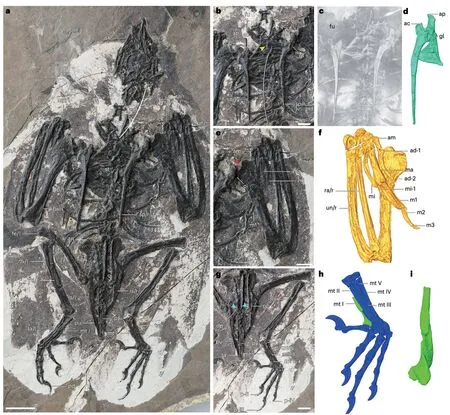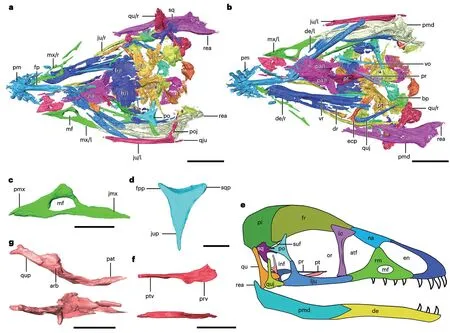Bizarre Cretaceous Bird from China Shows Evolutionarily Decoupled Skull and Body
2023-09-09
It is now widely accepted that birds are descended from dinosaurs.It is also understood that this transition encompasses some of the most dramatic transformations morphologically, functionally,and ecologically, thus eventually giving rise to the characteristic bird body plan.
However, paleontologists still scratch their heads to understand how this fantastic evolutionary event occurred.
Now, a new, complete 120-million-year-old fossil bird from China further complicates this issue by exhibiting a dinosaur-like skull articulated with a bird-like body.In addition, the fossil specimen, named Cratonavis zhui, preserves a surprisingly elongate scapula and first metatarsal, making it stand out from all other birds including fossil ones.

Figure 1: Photograph of the 120-million-year-old bird Cratonavis zhui.(Image by WANG Min)

Figure 2: Digital reconstruction of the skull of Cratonavis zhui.(Image by WANG Min)
The study, published inNature Ecology & Evolutionon January 2, was conducted by paleontologists from the Institute of Vertebrate Paleontology and Paleoanthropology(IVPP) of the Chinese Academy of Sciences (CAS).
Cratonavisis positioned between the more reptilelike long-tailedArchaeopteryxand the Ornithothoraces(which had already evolved many traits of modern birds)in the avian evolutionary tree.
To study the fossil skull, the scientists first used high-resolution computed tomography (CT)-scanning.They then digitally removed the bones from their rocky tomb and reconstructed the original shape and function of the skull.
The result demonstrates that theCratonavisskull is morphologically nearly identical to that of dinosaurs such asTyrannosaurus rexrather than being bird-like.“The primitive cranial features speak to the fact that most Cretaceous birds such asCratonaviscould not move their upper bill independently with respect to the braincase and lower jaw, a functional innovation widely distributed among living birds that contributes to their enormous ecological diversity,”said Dr.LI Zhiheng, a lead author of the study.
As for the bizarre scapula and metatarsal inCratonavis, Dr.WANG Min, a lead and corresponding author of this study, said, “The scapula is functionally vital to avian flight, and it conveys stability and flexibility.We trace changes of the scapula across the Theropod-Bird transition, and posit that the elongate scapula could augment the mechanical advantage of muscle for humerus retraction/rotation, which compensates for the overall underdeveloped flight apparatus in this early bird, and these differences represent morphological experimentation in volant behavior early in bird diversification.”
The new study shows that the first metatarsal was subjected to selection during the dinosaur-bird transition that favored a shorter bone.It then lost its evolutionary lability once it reached its optimal size, less than a quarter of the length of the second metatarsal.
“However, increased evolutionary lability was present among Mesozoic birds and their dinosaur kins,which may have resulted from conflicting demands associated with its direct employment of the hallux in locomotion and feeding,”said coauthor Dr.Thomas Stidham.ForCratonavis, such an elongate hallux likely stems from selection for raptorial behavior.
The aberrant morphologies of the scapula and metatarsals preserved inCratonavishighlight the breadth of skeletal plasticity in early birds, said coauthor Dr.ZHOU Zhonghe.Changes in these elements across the theropod tree show clade-specific evolutionary lability resulting from the interplay among development,natural selection, and ecological opportunity.
杂志排行
Bulletin of the Chinese Academy of Sciences的其它文章
- Unlocking the Secrets of Efficient Syngas Conversion: Researchers Discover Dual Active Sites on Bimetallic Oxide Catalyst
- Stealthy Invaders: How SARS-CoV-2 Evades Our Defenses and Spreads
- A Small Amino Acid, Big Impact: Methionine Restriction in Cancer Therapy
- New MERS-like Coronavirus Discovered in Pangolins
- Crop Switching for Improved Agricultural Sustainability in China
- Genomic Study of Ancient Humans Sheds Light on Human Evolution on the Qinghai-Tibetan Plateau
